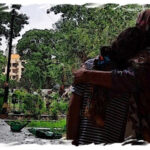The film Mrs Chatterjee vs Norway (Directed by Ashima Chibber/2023) has elicited strong appreciation from audiences. This largely emotional response is due to empathy for the character, which is aided by the sometimes loud, but mostly moving performance of Rani Mukherjee. The screenplay is adapted from Sagarika Chakaraborty’s book ‘The Journey of a Mother’. The fact that the film is based on real incidents also adds to the horror imagined at two levels. About what she must have gone through, and what if this had happened to me!
The third and perhaps strongest reason is the narrative’s emphasis on India’s ‘culture’ and ‘family values’ being not only misunderstood by the West but also criticised. The criticism is shown in the film as ridicule and disdain, and even disgust. The collective heart of the audience naturally rebels against the criticism of practices such as feeding children by hand since we have all been fed like that and have fed our children by hand too!
The protagonist complains in a scene that the government of Norway thinks of India as a “bhikaari” country ( a country of beggars).”Yeh desh ka matter hai” (This is a matter of concern for the nation,) she screams. The character she appeals to also brings back our memory of an external affairs minister who is no more. That, too, helps. But mainly, the idea that the world thinks of us Indians as uncivilised, inferior! The present atmosphere of nationalistic fervour practically makes it mandatory that we offer not just empathy but total identification with the Indian mother!
Two days after the release of the film, the Norwegian ambassador to India wrote in The Indian Express Norway’s Ambassador to India writes: ‘Mrs Chatterjee vs Norway’ doesn’t represent the deep care Norway has for families that the children were certainly not taken away from the family because they were allowed to sleep in the same bed, or fed with fingers. Although he does not divulge details of the particular case, he does underline the fact that “The Child Welfare Service can only intervene when neglect, violence or abuse is confirmed.”
Was there violence in this case? The film shows the husband slapping the wife. So, can the possibility of other forms of violence in the family be totally ruled out? What if the children of this family were beaten up? Do we not want intervention from authorities if children are being subjected to physical violence?
Have we become desensitised to the sounds of crying children that we hear in our building day in and day out? Is that, like a husband beating a wife, also a ‘family matter’ that deserves only a blind eye response? Is thrashing children an acceptable way of life? Is child-beating, if I may ask, an acceptable ‘Indian culture practice’?
I would like to give the example of another incident that occurred in a family of Indian origin living in the USA just a few years before the Norway incident.
Indian-American adoptive father of Sherin Mathews sentenced to life
Three-year-old Sherin’s body was found in a culvert near her house a fortnight after her Indian parents reported her missing. Wesley Mathews, the father, confessed that it was he who wrapped his dead adopted daughter in a blue trash bag and threw her in the culvert. He then went on to do laundry and clean up.
The medical examiner found post-mortem examination difficult as the body was decomposed. However, bones last, and the doctor noted various fractures. These were in different stages of healing. That means that Sherin’s parents had broken her bones on different occasions. Details of injuries, being kept in the snow etc., are available in newspaper reports and court judgements, and I do not want to list them here. But yes, I think we can see that physical violence had been inflicted on this child. The evidence that the authorities of the Referral and Evaluation of At Risk Children Clinic (REACH) had recorded over the years was vital in awarding a sentence to the perpetrator.
So, the infliction of physical violence on children cannot be ruled out. Intervention by authorities is sometimes required.
Also, about Indian cultural practices like allowing the children to sleep in the same bed. Yes, they may be culturally acceptable in India. But can we say that there are no cases of child abuse within Indian families? Are there no cases of child sexual abuse where the perpetrator is a close and trusted family member?
It becomes necessary that the child if she/he finds any domestic arrangement or practice uncomfortable, is allowed to talk to a teacher/doctor/social worker. That there be intervention. That there be a discussion with or, if necessary, even questioning of parents.
Even as we emotionally react to a good performance in a well-made popular film, let us not form hasty opinions. The state and society, without being obtrusive, should definitely intervene if children and women are being harmed even inside the walls of a home.
Domestic violence and child abuse are not ‘ghar ki baat’ or family matters. They are a matter of protection for the most vulnerable.



